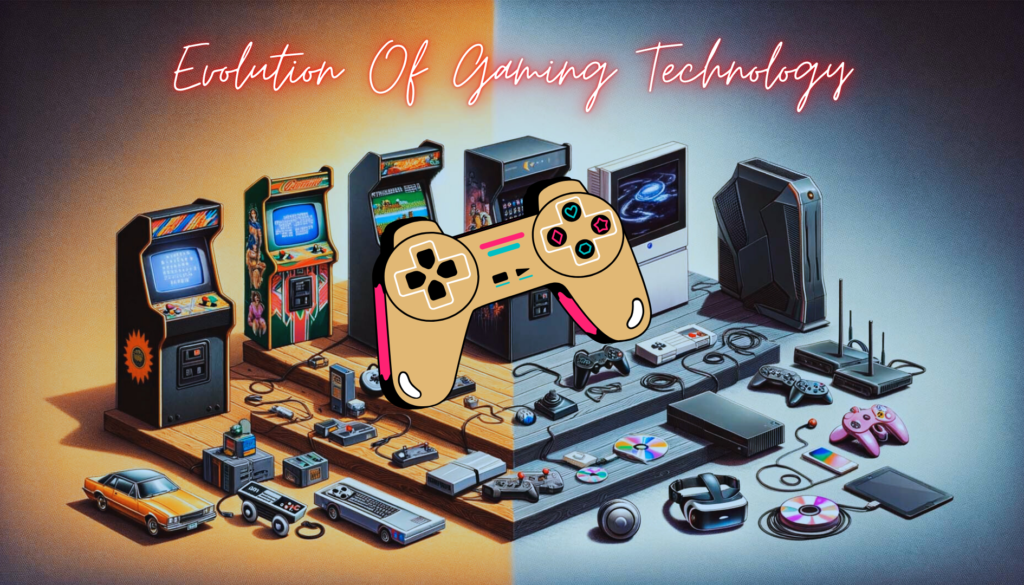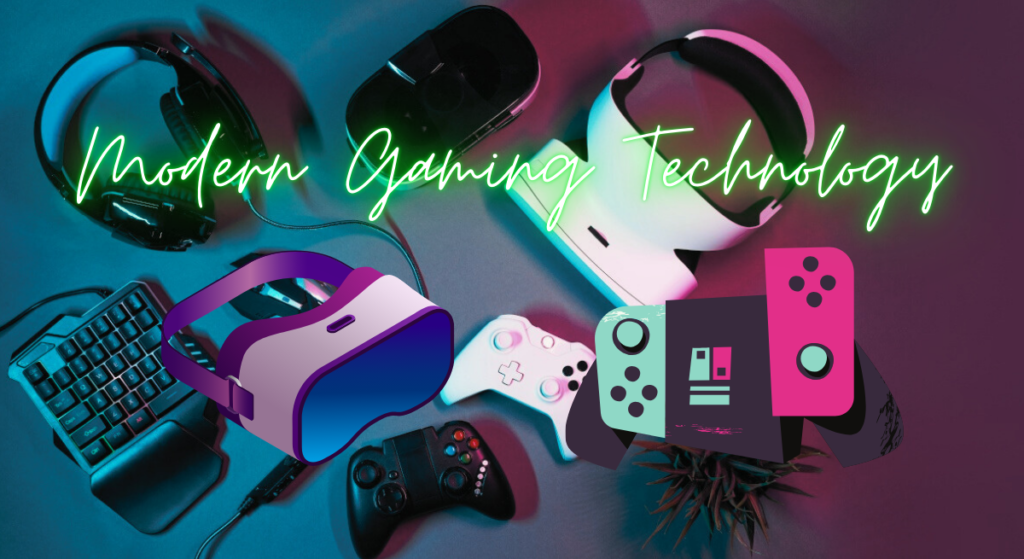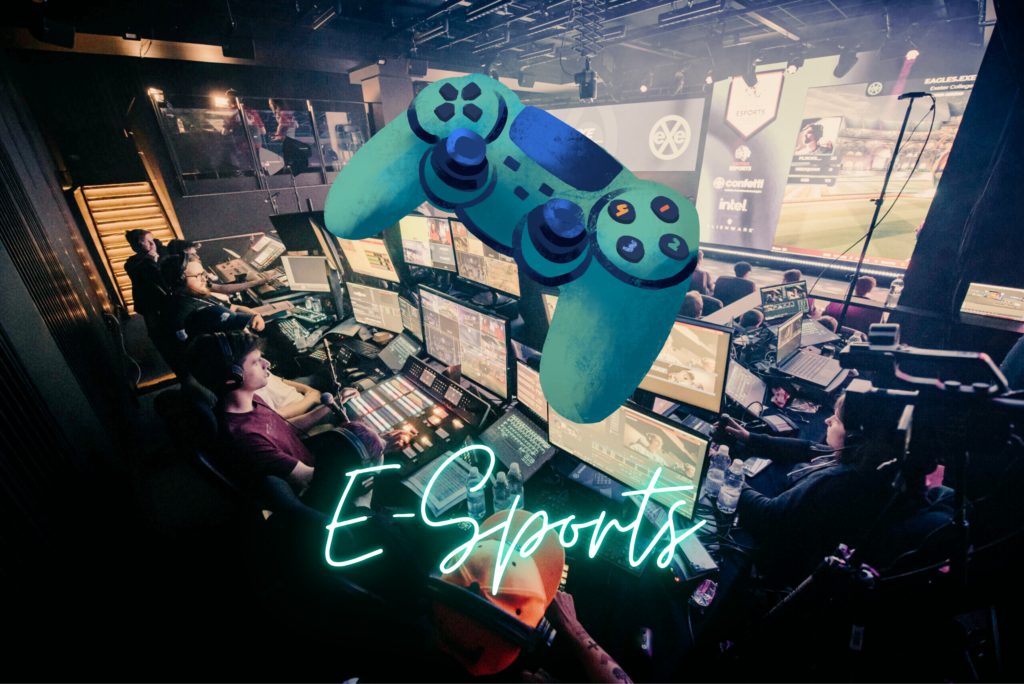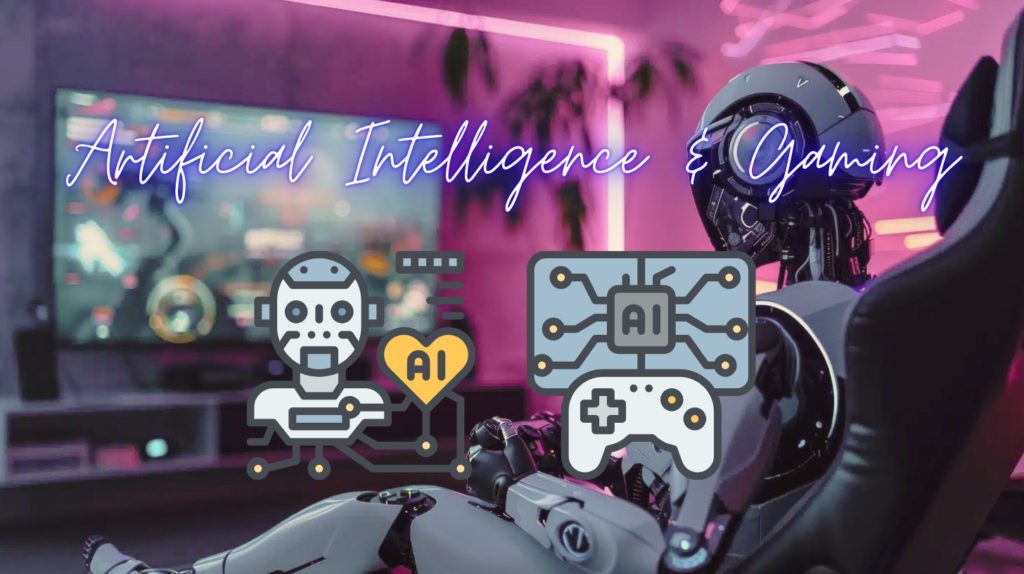Gaming technology has evolved dramatically over the years, from simple arcade systems to complex virtual reality settings. This revolution has had an impact not only on entertainment, but also on a variety of other industries, including education and healthcare.
The Evolution of Gaming Technology:
Early Days of Gaming Technology:
Gaming technology began in the 1950s with basic text-based games and progressed to pixelated 2D games in the 1980s.
- Arcade Games: The golden age of arcade gaming introduced the general public to commercially available gaming technologies. “Pac-Man” and “Space Invaders” were milestones.
- Home Consoles: The Nintendo Entertainment System (NES) and Sega Genesis were revolutionary in bringing gaming technology into the home.
- Graphics & Sound: Initially, this technology was constrained by hardware limitations. Graphics were rudimentary 2D sprites, with sounds limited to chiptune.
The Shift to 3D Gaming Technology:
The 1990s witnessed the emergence of 3D graphics and significant advances in game technology.
- Sony PlayStation and Nintendo 64 enabled developers to create 3D settings, laying the foundation for today’s open-world games.
- Realism: The new generation of this technology was characterized by more lifelike character models and environments. Titles such as “Super Mario 64” and “Tomb Raider” were pioneering.
- Cutscenes & Narratives: Story-driven games grew more widespread as this technology advanced, allowing creators to integrate more elaborate narratives.
The 2000s: HD Graphics & Online Multiplayer:
As this technology improved into the new millennium, high-definition visuals and online multiplayer features became the standard.
- Consoles such as the Xbox and PlayStation 2 advanced this technology with more computing power, improving both graphical fidelity and gameplay dynamics.
- Xbox Live and PlayStation Network pioneered online gaming for console users, allowing millions to join and play in real time.
- Mobile Gaming: Smartphones, such as the iPhone, heralded a new era in gaming technology, bringing casual games like “Angry Birds” and “Clash of Clans” to a wider audience.

Modern Gaming Technology:
Console Gaming Technology:
Modern consoles, such as the PlayStation 5 and Xbox Series X, have pushed the boundaries of game technology.
- 4K Graphics: Modern consoles can generate games at 4K resolution, resulting in crystal-clear graphics and dynamic lighting effects.
- Ray Tracing: Ray tracing, an invention in this technology, enables realistic lighting, shadows, and reflections.
- Backward Compatibility: Many newer consoles include backward compatibility, which allows gamers to play older games with improved gaming technology.
PC Gaming Technology:
Because of its adaptability, PC gaming has played an important role in pushing the boundaries of game technology.
- Graphics Cards: High-end GPUs such as NVIDIA’s RTX 30-series have revolutionized gaming visuals, making the PC the favored platform for players seeking cutting-edge gaming technology.
- Customization: With PCs, players can upgrade components, keeping their systems at the cutting edge of gaming technology.
- VR Compatibility: PCs are also at the forefront of virtual reality gaming, providing players with the best experience in this rapidly evolving sector of gaming technology.
Cloud Gaming Technology:
Cloud gaming is a new frontier in this technology, allowing gamers to stream games directly from servers without the need for high-performance hardware.
- Platforms: Google Stadia, NVIDIA GeForce Now, and Xbox Cloud Gaming have transformed this technology by providing subscription-based access to hundreds of games instantly.
- Accessibility: Cloud gaming technology reduces obstacles for gamers who cannot buy high-end gaming hardware by processing games in the cloud and streaming them to the user’s device.
- Latency Challenges: One of the disadvantages of cloud this technology is the possibility of latency, which might degrade real-time gameplay.
Virtual Reality (VR) Gaming Technology:
Virtual reality is a huge advancement in game technology that immerses players in a fully interactive 3D environment.
- Devices: Headsets such as the Oculus Rift, PlayStation VR, and HTC Vive use game technology to track player movements in real time.
- Applications: VR is not just for gaming; it is also used in training simulations, healthcare, and education, showcasing gaming technology’s versatility.
- Challenges: High hardware costs and motion sickness continue to be barriers to VR’s general adoption in gaming.
Augmented Reality (AR) Gaming Technology:
Unlike VR, which completely immerses players in a virtual world, AR seamlessly integrates virtual elements into the real world.
- Popular Games: Pokémon GO is an excellent illustration of how this technology may change the way people engage with both the digital and physical worlds.
- Hardware: AR game technology is often accessed via smartphones or specialized headsets such as Microsoft HoloLens.

Gaming Technology Beyond Entertainment:
Healthcare & Gaming Technology:
This technology has applications beyond entertainment, including healthcare.
- Therapeutic Games: Certain video games are utilized in therapeutic settings to assist individuals with mental health concerns or physical rehabilitation.
- Surgical Simulations: Gaming technology allows medical practitioners to rehearse complex surgery in virtual environments before doing them in real life.
Education & Gaming Technology:
Educational institutions are increasingly using gaming technologies to provide interactive learning experiences.
- Simulations: Teachers utilize game-based simulations to help pupils comprehend hard concepts such as physics and history.
- Gamification: Gaming technology principles, such as achievements and leveling systems, are used to inspire students in a range of courses.
Military Training & Gaming Technology:
The military employs gaming technologies to teach soldiers in a safe, virtual setting.
- Flight Simulators: Military pilots go through intensive training using flight simulators driven by modern gaming technologies.
- Virtual Combat: Soldiers are trained in combat scenarios utilizing gaming technology, which allows them to prepare for real-life encounters without jeopardizing their safety.
The Impact of Gaming Technology on Esports:
Esports, or competitive video gaming, has grown at an exponential rate, thanks in large part to advances in game technology.
- Streaming Platforms: Platforms like as Twitch and YouTube Gaming have made it simple for players and viewers to interact, watch live games, and compete in gaming tournaments. These platforms, which use gaming technology, have helped esports become a global phenomenon.
- Prize Pools: The advent of esports has resulted in large prize pools, with events such as The International (Dota 2) and the League of Legends World Championship awarding millions of dollars to winning teams. This success is attributed to the accessibility and ingenuity of modern game technology.
- Player Skill Development: Professional players’ abilities evolve in tandem with gaming technology. Esports athletes can perform to their full potential thanks to features such as high refresh rate monitors, snappy peripherals, and optimal network infrastructure.

Artificial Intelligence (AI) in Gaming Technology:
Artificial intelligence (AI) has revolutionized gaming technology, making it more dynamic, entertaining, and personalized. Here’s how AI is transforming the gaming experience:
Smarter NPC’s:
- AI has transformed how non-player characters (NPCs) behave.
- Traditional NPCs performed predetermined activities in repeating patterns.
- Modern artificial intelligence enables NPCs to learn and adapt in response to player activities.
- In Metal Gear Solid and The Last of Us, opponents react to players’ strategies, changing their behavior to deliver more difficult gameplay.
- AI-powered NPCs provide more realistic interactions, making games feel more immersive and unexpected.
Procedural Content Generation:
- AI is essential to procedural content generation (PCG), which enables games to construct enormous, distinct landscapes.
- Examples: In No Man’s Sky and Minecraft, which use AI to create huge, unpredictable worlds.
- This technology enables creators to generate endless worlds without personally developing every detail, hence increasing the game’s breadth and replayability.
- AI-generated material ensures that each player’s experience is unique, with limitless exploration and diversity.
Adaptive Difficulty:
- The game’s difficulty is customized to the player’s skill level owing to artificial intelligence.
- Gaming technology backed by AI can track player performance and alter challenges accordingly.
- Examples: In Left 4 Dead, AI modifies enemy behavior and spawn rates based on how well the player performs.
- This results in a more balanced experience, keeping players involved without overwhelming them or making the game too simple.
Personalized Experiences:
- AI can personalize gaming experiences by learning from player preferences and adapting gameplay accordingly.
- This technology allows for individualized tales, dynamic environments, and customizable challenges.

The Future of Gaming Technology:
The future of gaming technology promises to be transformative, with advances in artificial intelligence (AI), virtual reality (VR), augmented reality (AR), cloud gaming, and blockchain technology ready to reshape the gaming industry. These developments will influence how games are created, played, and experienced, resulting in unprecedented levels of immersion, interactivity, and accessibility.
AI-Driven Games:
- AI will continue to play an important part in the development of game technologies. Future games are likely to have even intelligent, autonomous NPCs who may learn, evolve, and react dynamically to their players’ actions and choices.
- These AI-driven NPCs will not only respond to immediate player actions, but will also form long-term connections and plans, resulting in unique gameplay experiences suited to each player.
- Dynamic Storylines: AI will enable the production of procedurally created storylines that evolve in response to user choices, allowing for more customized narratives. Instead of predetermined events, players can affect how the game progresses, resulting in an infinite number of tale possibilities.
VR and AR Integration:
- Virtual reality (VR) and augmented reality (AR) are projected to become more prevalent in mainstream gaming. VR will provide fully immersive environments as gear becomes more affordable and accessible, whilst AR will further integrate the digital and physical worlds.
- Haptic Feedback: Future VR technology will include enhanced haptic feedback, allowing players to “feel” in-game interactions and adding physicality to virtual experiences.
Cloud Gaming:
- Cloud gaming will transform the way games are played by eliminating the need for powerful hardware. Instead of purchasing pricey consoles or PCs, consumers would be able to stream games from cloud servers to mobile devices.
- As global internet infrastructure develops, gaming technologies will enable quick access to high-quality games on any device with an internet connection, bringing gaming to a wider audience.
Blockchain and NFTs:
- Blockchain technology will give gamers new methods to own, exchange, and monetize in-game assets. Non-fungible tokens (NFTs) will provide players actual ownership of unique in-game objects, characters, and skins.
- Play-to-Earn: The future of gaming technology could see the introduction of “play-to-earn” games, in which users can earn real-world money by participating in in-game economies or completing challenges.
FAQ’s
How is gaming technology impacting education?
Gaming technology is increasingly being employed in education to facilitate interactive learning. Educational games, simulations, and virtual classrooms enable students to interact with content in new and immersive ways.
What is the future of virtual reality in gaming technology?
The future of VR in gaming technology looks optimistic, with developments in hardware and software expected to result in more immersive experiences. Companies are also attempting to reduce costs and increase accessibility for a larger audience.
How does cloud gaming technology work?
Cloud gaming technology enables users to stream games from a remote server, removing the need for advanced hardware. Games are handled on powerful servers, and the video output is transmitted to the player’s device over the internet.
How is artificial intelligence used in gaming technology?
AI is utilized in gaming technology to produce more intelligent foes, dynamic worlds, and individualized gameplay. Machine learning enables games to adjust to a player’s skill level, making the experience more difficult or accessible as necessary.
Conclusion
Gaming technology continues to push the frontiers of what is possible in the entertainment and other industries. It evolved dramatically, from the first consoles to today’s virtual and augmented reality experiences. As emerging technologies like AI and cloud computing become more incorporated into the gaming world, the future presents tremendous opportunities for ever more immersive and engaging experiences.
The evolution of gaming technology is far from complete, and the next generation of gamers will definitely see levels of creativity that we can only conceive today.
